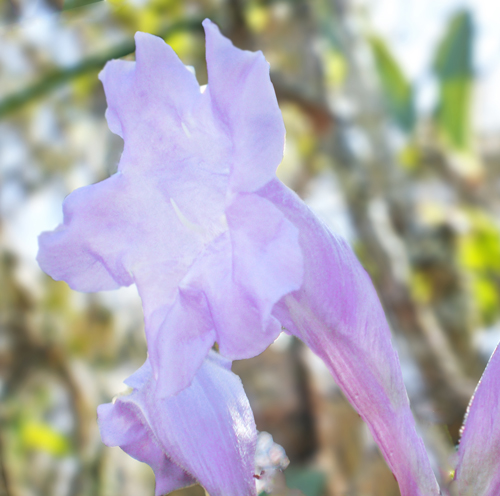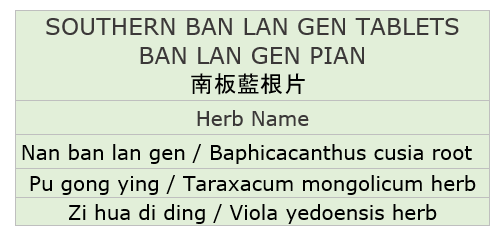Southern (Nan) Ban Lan Gen - An Important Herb for the Times
Originally published February 15, 2022

Since the spring of 2020, our world has faced many challenges, and possibly has been gifted an equal number of opportunities for change. We could also speculate that at no other time in modern history has there been a greater moment for Chinese herbal medicine (CHM) to be a partner in resolving some of our most prevalent health concerns.
One clear example of such an herb is Nan Ban Lan Gen (南板藍根), Baphicacanthus cusia root, which is the key component of Mayway’s Ban Lan Gen Tablets / Nan Ban Lan Gen Pian ( 南板藍根片). This important formula was introduced in July of 2018, as an alternate means of administration for Ban Lan Gen Chong Ji 板藍根沖劑, which is an extract infusion containing cane sugar. This powerful three-herb formula is well known in China for its antiviral and antibacterial action and was found to be widely useful to treat patients during the 2002 SARS epidemic in China. Its value was reiterated in Oct. 2020 by China’s foremost respiratory disease specialist, Zhong Nan Shan, for the current situation.
There are many herbs in China that are known as Ban lan gen. The standard herb listed in the Pharmacopoeia of the People’s Republic of China (PPRC) is Isatis indigota Fort. (Family Cruciferae). Because this herb grows primarily in Northern China, it is known as Bei ban lan gen 北板藍根, and the PPRC-accepted alternative species, Baphicacanthus cusia is known as Nan ban lan gen 南板藍根 since it is grown primarily in Southern China.

This practice of using one common name for more than one herb has regional and historical causes; for example, in substituting a local species for the standard species if it was not available. In northern China, when Ban lan gen is prescribed, it is usually Radix Isatis indigota. However, in southern China when Ban lan gen is prescribed, often Radix Baphicacanthus cusiae is given instead. While both have the Traditional Chinese Medicine (TCM) functions of Draining Heat, Resolving Toxic Fire, Cooling the Blood and modern applications for resolving Warm Heat pathogens, there are some differences between their documented antiviral properties and bioactive compounds that led to the inclusion of Nan ban lan gen in the products referenced above. For more information, we invite you to examine the references listed below. Both herbs are commonly used in the preparation of Qing dai, Indigo Naturalis, which is fermented by special process using the leaf or leaf and stem of three species specified by the PPRC: Baphicacanthus cusia (Nees) Bremek. (Family Acanthaceae), Polygonum tinctorium Ait. (Family Polygonaceae) or Isatis indigota Fort. (Family Cruciferae).
The TCM functions for Ban Lan Gen Tablets are: Clears Heat, Expels Toxic-Heat, Benefits the Throat, Invigorates the Blood, and Mobilizes the Wei-protective Qi. When Nan Ban Lan Gen is combined with Pu Gong Ying and Zi Hua Di Ding, this powerful little formula expels Wind-Heat, drains Heat via the urination, enters both Qi and Blood levels, as well as the Liver, Stomach and Heart channels.
Ban Lan Gen Tablets are an indispensable addition to your clinical inventory and can provide relief for a wide variety of Wind-Heat invasions. For early stages of this type of presentation, alternate with Gan Mao Ling Tablets or Yin Qiao Tablets at up to twice the dose. For stronger signs of heat in the throat, combine with Chuan Xin Lian Tablets. Standard dosage of Ban Lan Gen Tablets is: 3 tablets 3 x daily as needed and would be used with caution in hemorrhagic disorders or with patients on anti-coagulant therapy. This formula may be used short term for a few days to a few weeks.

REFERENCES
- Bensky, Clavey, Stoger. Chinese Herbal Medicine: Materia Medica 3rd Ed. Eastland Press: Seattle, 2004
- Brand, E. Herbal Identification: The Clinical Implications of an Ancient Art, Journal of the Register of Chinese Herbal Medicine, U.K., Spring, 2015
- Chinese Pharmacopoeia Commission. Pharmacopoeia of the Peoples Republic of China. Beijing: China Medical Science and Technology Press, 2015 English edition.
- Du, J., Wang, B., Chen, J., Zhang, Z., Li, S., He, L., Lai, X., Zhang, D., & Wang, K. (2016). Extraction, characterization, and bioactivities of novel purified polysaccharides from Baphicacanthus Cusiae Rhizoma et Radix. International journal of biological macromolecules, 93(Pt A), 879–888. https://doi.org/10.1016/j.ijbiomac.2016.09.055
- Fielding, B. C., da Silva Maia Bezerra Filho, C., Ismail, N., & Sousa, D. P. (2020). Alkaloids: Therapeutic Potential against Human Coronaviruses. Molecules (Basel, Switzerland), 25(23), 5496. https://doi.org/10.3390/molecules25235496
- Wrinkle, A. et al., A Practitioner’s Formula Guide, Elemental Essentials Press: 2008.
- Xu, Z., Cai, Y., Ma, Q., Zhao, Z., Yang, D., & Xu, X. (2021). Optimization of Extraction of Bioactive Compounds from Baphicacanthus cusia Leaves by Hydrophobic Deep Eutectic Solvents. Molecules (Basel, Switzerland), 26(6), 1729. https://doi.org/10.3390/molecules26061729
- Yu, J., Zhang, Y., Ning, S., Ye, Q., Tan, H., Chen, R., Bu, Q., Zhang, R., Gong, P., Ma, X., Zhang, L., & Wei, D. (2019). Molecular cloning and metabolomic characterization of the 5-enolpyruvylshikimate-3-phosphate synthase gene from Baphicacanthus cusia. BMC plant biology, 19(1), 485. https://doi.org/10.1186/s12870-019-2035-0
- Zhongzhen Zhao et al (2006). Ann Acad Med Singapore 2006; 35:764-9. Confused Species of Chinese Materia Medica in HK. https://annals.edu.sg/pdf/35VolNo11Nov2006/V35N11p764.pdf
- Zhou, B., Yang, Z., Feng, Q., Liang, X., Li, J., Zanin, M., Jiang, Z., & Zhong, N. (2017). Aurantiamide acetate from Baphicacanthus cusia root exhibits anti-inflammatory and anti-viral effects via inhibition of the NF-κB signaling pathway in Influenza A virus-infected cells. Journal of ethnopharmacology, 199, 60–67. https://doi.org/10.1016/j.jep.2017.01.038


